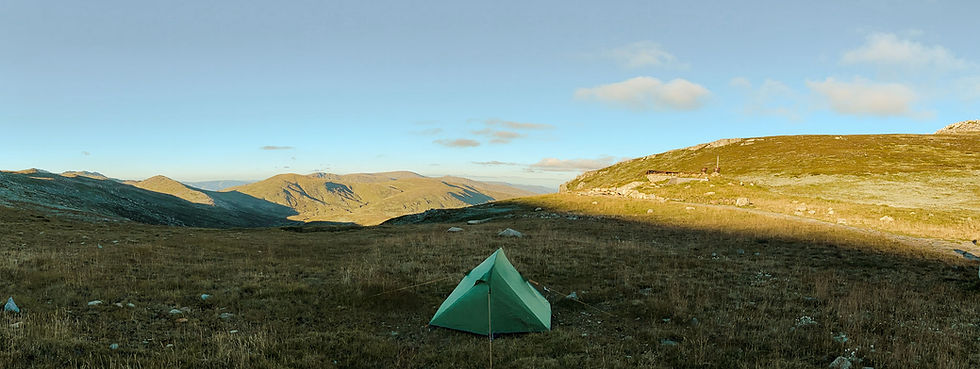MOUNT KOSCIUSZKO OVERNIGHT HIKE
- becandclark
- Mar 23, 2023
- 5 min read
Updated: Apr 5, 2024
KNOW BEFORE YOU GO
Mount Kosciuszko is the tallest mountain peak in Australia, standing at 2,228 m (7,310 ft) above sea level. It is generally open year-round, boasting incredible walking tracks and bike trails in the warmer months and snowfields over winter. If camping on top of Mount Kosciuszko is on your bucket list, here are a few things to know before you go.

QUICK LINKS
ABOUT THE TRAIL
Mount Kosciuszko is located within Kosciuszko National Park in southeast New South Wales. It is the largest national park in the state, spanning 690,000 hectares. There are many beautiful places and exciting activities within the park, but the most notable is the mountain that shares its name.
There are multiple ways to reach the summit of Mount Kosciuszko, but this guide details a route starting on the Main Range walk and looping back via the Summit walk. This loop track is 22 km (13.7 mi) long and takes 7-9 hours. It is rated grade 4, with an intermediate level of fitness and bushwalking experience recommended. It is a clearly marked trail with some rocky sections, stairs, and steep gradients.
It is possible to complete the hike in one day if you prefer.
This hike is best during the warmer months. However, being in an alpine environment where the weather can change rapidly, it is important to check the forecast before leaving and be prepared with clothing and equipment. In winter, the mountain is a snowfield, open for cross-country skiing and snowshoeing.
There are restrictions on where you can camp, which are clearly signposted along the trail. Avoid alpine lake catchments and stay 200 m (656 ft) away from chairlifts, power stations, river crossings and public roads.
THE EXPERIENCE
The 22 km walk starts at Charlotte Pass. The track crosses the famous Snowy River via a line of stepping stones and then begins the first long incline. At the end of this section, there is an optional detour to the Blue Lake. If you choose to take this track, you will then return the same way, back to the Main Range walk. From here, you will start to head over the ranges.
Take your time walking this section and enjoy the spectacular views. In summer, we were treated to wildflower meadows, glacial lakes, and uninterrupted views across the Australian Alps. There are also many great spots along the way to stop for lunch.
Before reaching the peak, you will climb a long set of uneven stone steps to Rawson Pass, then turn onto the summit path to complete the final gradual incline to the rooftop of Australia. At the end, you are rewarded with spectacular 360-degree views of the surrounding ranges.
Nearing the summit, the weather can change drastically. You may experience the harsh Australian sun and strong, icy winds all at the same time. Once the sun sets, the temperature will also drop.
We visited in mid-February, where it reached 30 degrees Celsius (86 degrees Fahrenheit) during the day but dropped to 2 degrees Celsius (35 degrees Fahrenheit) at night.
You cannot camp within 200 m (656 ft) of the summit, so when you are ready, venture back down to Rawson Pass and pick a spot for the night. After the sun has set, before you jump into your sleeping bag, soak up the peace and quiet, gazing up at the star-studded night sky.
Continue reading below for more information on ‘Where To Stay’.
Wake to the sunrise, which you can enjoy looking out across the valley from your tent or sitting up at the summit once again. Fuel up on coffee and breakfast, then begin the descent on the Summit walk. This section of track is less strenuous than the Main Range walk and mostly downhill. Stop by the Seaman’s hut and the Snowy River Crossing before returning to Charlotte Pass.
GETTING THERE
Kosciuszko National Park is a 5-6 hour drive from Sydney or 2 hours and 30 minutes from Canberra. The best way to get around the park is by car.
A Park Pass is required for entry into Kosciuszko National Park. The cost varies depending on the time of year. Over the warmer months, when it’s best to do this hike, the day rate is $17 per vehicle. You will need a multi-day pass if you are completing this hike overnight. You can purchase these passes from the vehicle entry stations or National Parks and Wildlife Service Visitor Centres.
Visit the Kosciuszko National Park website for more information on Park Passes.
The car park at Charlotte Pass is timed, with a limit of 20 minutes. You will need to park along the side of the road instead, where there is no limit. There is plenty of space, but it will fill up quickly, so get in early to avoid parking far away.
WHAT TO PACK & WEAR
What you need to pack and wear will differ depending on the season. As mentioned, it is best to complete this hike in the warmer months, so this list is based on those conditions.
CLOTHING
Appropriate exercise/hiking clothes.
Waterproof and windproof layers.
Waterproof hiking boots and comfortable socks.
Hat and sunglasses.
Gloves, a beanie and a hiking bandana.
Warm layers for nighttime.
Fresh pair of clothes for the second day.
PACKING
Water for 2 days - we took 4 litres each.
Food – we took lunch, dinner, breakfast and snacks. No open or wood fires are permitted, so pack pre-prepared food.
Hiking tent.
Sleeping bag – with a temperature rating to cover the alpine weather.
Sleeping mat and pillow – we did without these, but they would add extra comfort.
Other camping comforts you may desire.
Sunscreen – there is no shade on this hike, so be sure to apply before and at regular intervals.
Rubbish bag – be sure to take everything off the mountain, including any toilet waste if you’re not utilising the toilet block at Rawson Pass.
Toilet paper.
Hand sanitiser.
First aid kit.
Torch, headlamp and extra batteries.
Personal Locator Beacon – if you want a PLB, you can hire one from the Visitor Centres. Ask about this when purchasing your park pass.
WHERE TO STAY
Camping on the Mountain – Rawson Pass
Although this area is full of tourists during the day, at night, it is an obvious choice for camping near the summit. There is a large, flat grass area right next to the path where the surrounding peaks help block out the wind, and the toilet block is open all night. Yes, there are toilets on top of the mountain! They are not the fanciest, but it's still a luxury for camping. This spot is also very convenient if you decide to hike to the summit for sunrise.
Kosciuszko National Park – Island Bend Campground
If you are not camping on the mountain or want somewhere for the night before and after, this campground is a great choice. There are plenty of spaces, most accessible by all vehicles. The sites are unmarked, so it’s first in best dressed, but you will need to make a booking, which includes a small fee. The bathrooms are drop-toilets, but we found them to be impeccably clean and the nicest we’ve ever used.
A good fact to know: Summer through Autumn is Horse/March Fly season. They are relentless, they bite, and a simple spray of bug repellent doesn’t do much to keep them at bay. A campfire helps (if there are no fire bans), and once the sun sets, they usually disappear.
Jindabyne – Alpine Gables
If you are not camping or want somewhere with a shower once you’ve completed the hike, Alpine Gables is a good choice. This hotel is close to the shops, restaurants and pubs. Most importantly it has a big bed, warm shower and is comfortable and clean. This hotel is most affordable in the warmer months, as the peak season for Jindabyne is winter.






















Comments